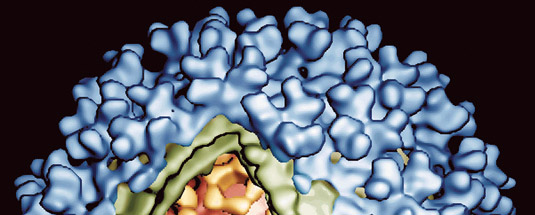 Epidemics on the Horizon Epidemics on the Horizon
With expertise and collaborations
that span both human and animal medicine,
UC Davis is helping the world
understand and prevent diseases
that threaten to become
the next pandemic.
By Pat Bailey
Because they swept through towns and villages in waves of sickness and death, then disappeared in the ashes, the ancient Greeks called epidemics something “visited upon the people.”
Today, public health officials say we are in the midst of many epidemics. Smoking, auto accidents, heart disease, cancer, poverty—all are shortening life and dimming its quality around the world. Still, it is infectious diseases that intrigue and perhaps frighten us most. Caused by viruses, bacteria and other microbes, these diseases often dwell in animal species, then spring up to touch humans in unpredictable outbreaks and occasional global pandemics.
Just a handful of diseases cause 90 percent of all infectious disease deaths, according to the World Health Organization. In fact, just six diseases—pneumonia, tuberculosis, diarrheal diseases, malaria, measles and AIDS/HIV—are responsible for half of all premature deaths around the world.
Many of these diseases have been eliminated or at least managed in richer nations, as is the case with polio and AIDS, respectively, but they continue to ravage developing countries, where vaccines, medicines and sanitary water are less available.
“We in the industrialized nations are in denial because we haven’t had to deal with epidemics. Disease isn’t part of our everyday life as it used to be,” said Catherine Kudlick, a UC Davis historian who has studied the history of epidemics.
And yet, just as some infectious diseases are being harnessed or eradicated, others, like SARS (Severe Acute Respiratory Syndrome), mad cow disease and avian influenza, are emerging or reappearing.
Upward of 300 diseases—75 percent of all emerging diseases—are transmitted from animals to humans, according to Bruno Chomel, a veterinary professor at UC Davis who studies such “zoonotic” diseases, most of which are spread by mosquitoes, ticks, lice and biting flies, he says.
Chomel says that we humans often bring infectious disease outbreaks upon ourselves by the way we interact with our environment—pushing homes and enterprises into previously wild areas, increasing international trade and travel, and fueling global climate change.
In laboratories and clinics, scores of UC Davis scientists and physicians are tackling the challenges of infectious diseases and the epidemics they cause. In addition to providing treatment for patients, the campus is working to better understand the biology of diseases, as well as their historical and economic impacts, and to develop new detection technologies, diagnostics, vaccines and drug therapies.
Related stories:
Uniting Against a Possible Pandemic
The Top 10: Epidemic Hall of Infamy
Predicting Future Epidemics
A Big Look at Small Invaders
Ducking Bird Flu and other Contagious Diseases

Pat Bailey writes about the agricultural and veterinary sciences for UC Davis.
|

